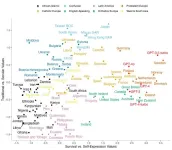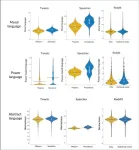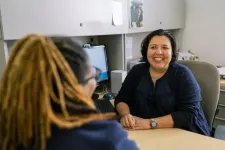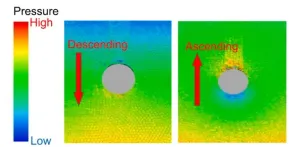In a new study, MIT physicists propose that if most of the dark matter in the universe is made up of microscopic primordial black holes — an idea first proposed in the 1970s — then these gravitational dwarfs should zoom through our solar system at least once per decade. A flyby like this, the researchers predict, would introduce a wobble into Mars’ orbit, to a degree that today’s technology could actually detect.
Such a detection could lend support to the idea that primordial black holes are a primary source of dark matter throughout the universe.
“Given decades of precision telemetry, scientists know the distance between Earth and Mars to an accuracy of about 10 centimeters,” says study author David Kaiser, professor of physics and the Germeshausen Professor of the History of Science at MIT. “We’re taking advantage of this highly instrumented region of space to try and look for a small effect. If we see it, that would count as a real reason to keep pursuing this delightful idea that all of dark matter consists of black holes that were spawned in less than a second after the Big Bang and have been streaming around the universe for 14 billion years.”
Kaiser and his colleagues report their findings today in the journal Physical Review D. The study’s co-authors are lead author Tung Tran ’24, who is now a graduate student at Stanford University; Sarah Geller ’12, SM ’17, PhD ’23, who is now a postdoc at the University of California at Santa Cruz; and MIT Pappalardo Fellow Benjamin Lehmann.
Beyond particles
Less than 20 percent of all physical matter is made from visible stuff, from stars and planets, to the kitchen sink. The rest is composed of dark matter, a hypothetical form of matter that is invisible across the entire electromagnetic spectrum yet is thought to pervade the universe and exert a gravitational force large enough to affect the motion of stars and galaxies.
Physicists have erected detectors on Earth to try and spot dark matter and pin down its properties. For the most part, these experiments assume that dark matter exists as a form of exotic particle that might scatter and decay into observable particles as it passes through a given experiment. But so far, such particle-based searches have come up empty.
In recent years, another possibility, first introduced in the 1970s, has regained traction: Rather than taking on a particle form, dark matter could exist as microscopic, primordial black holes that formed in the first moments following the Big Bang. Unlike the astrophysical black holes that form from the collapse of old stars, primordial black holes would have formed from the collapse of dense pockets of gas in the very early universe and would have scattered across the cosmos as the universe expanded and cooled.
These primordial black holes would have collapsed an enormous amount of mass into a tiny space. The majority of these primordial black holes could be as small as a single atom and as heavy as the largest asteroids. It would be conceivable, then, that such tiny giants could exert a gravitational force that could explain at least a portion of dark matter. For the MIT team, this possibility raised an initially frivolous question.
“I think someone asked me what would happen if a primordial black hole passed through a human body,” recalls Tung, who did a quick pencil-and-paper calculation to find that if such a black hole zinged within 1 meter of a person, the force of the black hole would push the person 6 meters, or about 20 feet away in a single second. Tung also found that the odds were astronomically unlikely that a primordial black hole would pass anywhere near a person on Earth.
Their interest piqued, the researchers took Tung’s calculations a step further, to estimate how a black hole flyby might affect much larger bodies such as the Earth and the moon.
“We extrapolated to see what would happen if a black hole flew by Earth and caused the moon to wobble by a little bit,” Tung says. “The numbers we got were not very clear. There are many other dynamics in the solar system that could act as some sort of friction to cause the wobble to dampen out.”
Close encounters
To get a clearer picture, the team generated a relatively simple simulation of the solar system that incorporates the orbits and gravitational interactions between all the planets, and some of the largest moons.
“State-of-the-art simulations of the solar system include more than a million objects, each of which has a tiny residual effect,” Lehmann notes. “But even modeling two dozen objects in a careful simulation, we could see there was a real effect that we could dig into.”
The team worked out the rate at which a primordial black hole should pass through the solar system, based on the amount of dark matter that is estimated to reside in a given region of space and the mass of a passing black hole, which in this case, they assumed to be as massive as the largest asteroids in the solar system, consistent with other astrophysical constraints.
“Primordial black holes do not live in the solar system. Rather, they’re streaming through the universe, doing their own thing,” says co-author Sarah Geller. “And the probability is, they’re going through the inner solar system at some angle once every 10 years or so.”
Given this rate, the researchers simulated various asteroid-mass black holes flying through the solar system, from various angles, and at velocities of about 150 miles per second. (The directions and speeds come from other studies of the distribution of dark matter throughout our galaxy.) They zeroed in on those flybys that appeared to be “close encounters,” or instances that caused some sort of effect in surrounding objects. They quickly found that any effect in the Earth or the moon was too uncertain to pin to a particular black hole. But Mars seemed to offer a clearer picture.
The researchers found that if a primordial black hole were to pass within a few hundred million miles of Mars, the encounter would set off a “wobble,” or a slight deviation in Mars’ orbit. Within a few years of such an encounter, Mars’ orbit should shift by about a meter — an incredibly small wobble, given the planet is more than 140 million miles from Earth. And yet, this wobble could be detected by the various high-precision instruments that are monitoring Mars today.
If such a wobble were detected in the next couple of decades, the researchers acknowledge there would still be much work needed to confirm that the push came from a passing black hole rather than a run-of-the-mill asteroid.
“We need as much clarity as we can of the expected backgrounds, such as the typical speeds and distributions of boring space rocks, versus these primordial black holes,” Kaiser notes. “Luckily for us, astronomers have been tracking ordinary space rocks for decades as they have flown through our solar system, so we could calculate typical properties of their trajectories and begin to compare them with the very different types of paths and speeds that primordial black holes should follow.”
To help with this, the researchers are exploring the possibility of a new collaboration with a group that has extensive expertise simulating many more objects in the solar system.
“We are now working to simulate a huge number of objects, from planets to moons and rocks, and how they’re all moving over long time scales,” Geller says. “We want to inject close encounter scenarios, and look at their effects with higher precision.”
This work was supported in part by the U.S. Department of Energy and the U.S. National Science Foundation, which includes an NSF Mathematical and Physical Sciences postdoctoral fellowship.
###
Written by Jennifer Chu, MIT News
END





